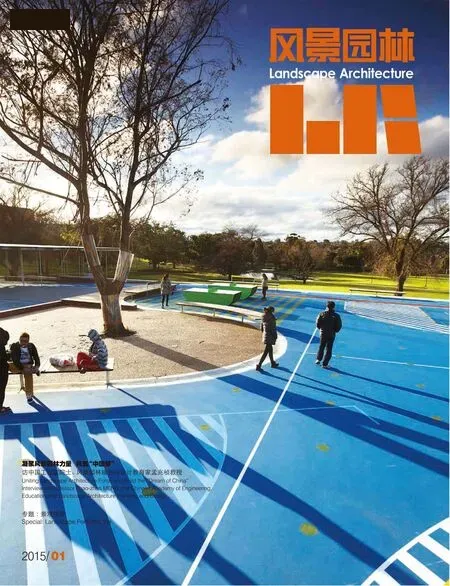刊首语
刊首语

对《风景园林》来说,2014年是一段历史的结束,在大家的关爱和呵护下她走过了10个年头。在出版的60余期刊物中,发表了800余篇来自中国和世界各地作者的论文,它们涉及到当今中国和国际上风景园林发展最前沿和最敏感的问题;还收录了600余个分布在中国和世界各处的风景园林项目,其中大多数是国内外风景园林领域关注的具有思想性和探索性的作品
2015年是一个新的开始。《风景园林》将全面改版,并由双月刊改为月刊。杂志仍将致力于推出国内外风景园林领域最前沿的研究成果,记录国内外风景园林、城市设计、公共艺术等领域的重要事件、新锐思想和优秀作品,但信息会比以往更迅速、更及时。
在今天,似乎每一项行动都要谈绩效,要预测或评估这项行动将要取得、或已经取得的成绩与效益。或许杂志也一样,回顾杂志过去的10年,是对杂志以往绩效的总结;计划杂志的未来,也是对杂志将来绩效的设想。本期杂志的主题就是关于绩效,是景观的绩效。
每个规划设计师都会有体会,几乎在每一项设计的文本的最后都有对这个项目实施后可能产生的社会效益、经济效益和环境效益的描述,但这一部分内容似乎并没有多少人关心,至于这些预测是否有根据,是否科学,也很少有人提出质疑。更不知道有多少设计师会跟踪自己的项目,评估项目在实施后是否真的取得了这些效益。
以我的经验,景观绩效的预判是非常困难的。多数设计师会带着美好的愿望,过高地预计了景观实施后可能带来的效益。景观也不是恒定的,在设计、建造、使用和管理中都充满了变数,景观并不完全按照预设的轨迹来运行,既使是建立在全面、科学分析基础上的效益预判,就一定能够完全实现吗?
另外,景观是一个非常复杂的综合体,涉及社会、科学、经济和艺术等诸多方面,它们密不可分,相辅相成。景观依附于大地,与土地的自然历史与文化历史密切相连。它要在一定的经济条件下实现,要满足社会的功能,要符合自然的规律,遵循生态的原则。景观也属于艺术的范畴。每个景观项目都有侧重,都会有不同。某些风景园林项目在一些方面的效益非常出众,但在另外一些方面的效益就不那么明显,甚至有所欠缺。景观规划设计的目标在不同方向的追求并不相同,有时甚至充满矛盾。比如一个城市公园,究竟应该设计成有许多场地和设施可以健身、活动和休息的公园,还是设计成能够有效地进行雨洪管理,创建动植物栖息地的生态绿地?前者可以吸引大量市民使用,社会效益很高,但绿地的比例相对会低,生态效益会弱;后者生态效益很高,但忽视了人的使用,社会效益较差。还有,如果一个城市广场有较好的景观效果并受到公众的欢迎,但需要高额的资金来维护,它能够算是一个好作品吗?
景观还是动态的,景观的绩效也应该是动态的。有些效益,今天没有显现出来,并不意味着它不存在或者未来也不可能出现;有些效益,现在非常突出,并不意味着能持续永久。我们把景观的绩效放在哪一个时间点或时间段来评价呢?
景观复杂而综合,每一个项目都有其独特性。在我看来,对景观效绩的研究并不能对景观应该如何设计给出答案。但提出问题往往比解决问题更重要,研究的过程也往往比研究的结果更有价值。景观绩效概念的提出与研究,会让每一个设计师更关注景观各个目标之间的平衡,追求具有合理的使用,良好的生态效益、经济效益及高质量的艺术水准的作品。
PREFACE
2014 has been a closure of a historical period for Landscape Architecture. She has been going, under deep concern and love from all of you, strong for a solid 10-years now. Among the 60 and more issues, there have been more than 800 pieces of articles from home and abroad concerning the most cutting-edge and the most sensitive issues in current development of landscape architecture both of China and the world; there also have been 600 and more pieces of inclusions of landscape architecture projects distributed throughout China and the world, most of which are of great ideological and exploratory values in the world’s focused landscape architecture fi elds.
2015 will be a new chapter for Landscape Architecture. There is a throughout revision on the layout going on and there also is the shift from bimonthly to a monthly journal. What remains unchanged is our endeavor to the promotion of leading research fi ndings in the field of landscape architecture as well as the documentation of important events, pioneer ideas and outstanding projects in fields of landscape architecture,urban design, public art, etc., domestically and externally,only that it will be more rapid and timely than ever.
Nowadays, it seems that almost every operation is required to be predicted or evaluated for the achievements and performances acquired or to be acquired. Perhaps the case is the same in our journal. Reviewing the past 10 years is the summarization of the journal’s previous performances; while planning for the future is the prospection for the future performances of the journal. This issue is exactly about performance, the performance of landscape.
Probably every planer designer has experienced that although they would put a detailed description of whatsocial benefits, economic benefits or environmental benefi ts the project may generate, there seems to be little attention being paid on such part. As to whether such prediction is scientifi c or well-founded, there also appears to be little questions raised. Never even knew how many designers would track their own projects and evaluate whether their predicted performances are realized.
In my experience, it is very difficult to predict the performance of landscape. Most designers, despite their glorious wishes, have overestimated the landscape performances of their projects after implementation. Landscape is not constant. Variables are used in the process of design, construction, application and management, and landscape is not operated strictly on presupposed tracks. Therefore, landscape performance is unlikely to realize completely as expected even the prediction is established comprehensively and scientifi cally.
Besides, landscape is a really complicated complex involving society, science, economy, art and many other inseparable and complementary aspects. Landscape depends on the earth, and is linked to its natural and cultural history. It is realizable only under certain economic conditions, and it needs to fulfill its social functions, and it has to conform to natural laws and ecological rules. Landscape also belongs to an category of art. Every landscape project has its focus and its uniqueness. Some landscape architecture projects’performances are outstanding in some aspects, however in other fi elds, they are inevitably weak, or even defi cient. The objectives of landscape planning and design differs in different directions, sometimes it is even contradictory. Take an urban park for example. Whether it should be designed to be a public garden with plentiful space and facilities for exercises, activities and relaxation, or a ecological green space with the abilities for management of stormwater and creation of habitats for animals and plants? The former one, which is of high social benefi ts,has the ability to absorb usage from the public, and yet its ecological benefi ts will be relevantly weaker for the green spaces are relevantly less; while the later one is just the opposite. Moreover, even if the park is of high landscape effect and at the same time is widely welcomed, but it requires expensive maintenance, can we call it a good piece of work?
Moreover, landscape is dynamic, therefore its performances should also be considered as dynamic. For example, some performances may not reveal today, but it doesn’t mean that they do not exist or they won’t be seen in the future; other performances may be outstanding now, but they may not last. So, on which time period or timing should we place our evaluation of the landscape performance?
Landscape is complicated and comprehensive,therefore every project is unique. As far as I can see,researching on landscape performance dose not answer the question of how to design a landscape project. However, it is more important to pose a question than to solve one, and it is more valuable in the process of researching than the outcome of the research itself. Putting forward and researching on the concept of landscape performance would draw more attention of the designers to be paid on the balance among each objective of the landscape, making it an high-quality piece of work with reasonable utilization, valuable ecological and economic benefi ts and favorable artistic standards.
January 18, 2015 WANG Xiang-rong

